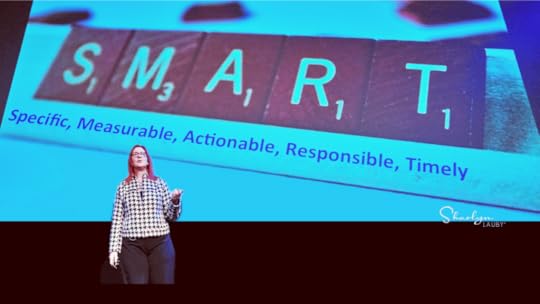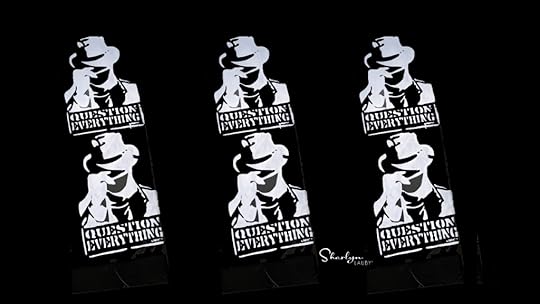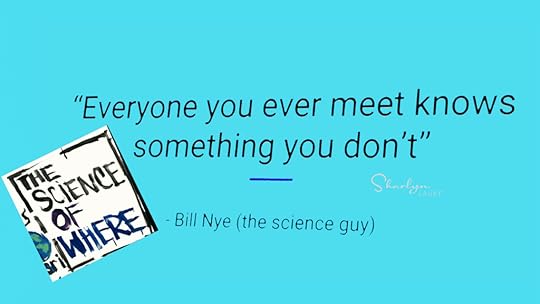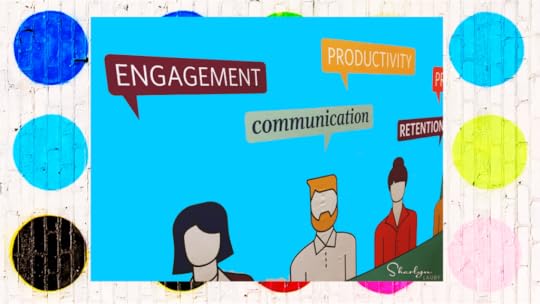Sharlyn J. Lauby's Blog, page 30
November 12, 2023
The Most Productive Ways to Spend the Last Two Weeks of the Year

Estimated reading time: 4 minutes
I’ve mentioned a few times recently about projects that might be perfect for the end of the year and thought it would be good to expand on the idea.
When I worked in a corporate office, I often worked during the final two weeks of the year. At first, because I had to. Everyone else had more seniority and vacation time. Later in my career, I did it because I wanted to. The final two weeks of the year were quiet. Fewer meetings. Less email. I could be productive, catch up, and cross off a few things on my “to-do” list.
So, if you’re looking at your schedule and are unhappy about having to work while your colleagues are taking time off, let me share a few things you can do to prepare for the upcoming year. In fact, you might want to bookmark this page and use it as an end-of-the-year checklist.
Clean out your contacts. I’m not talking about unfriending or unfollowing people, although you might want to do that too. I’m referring to professional contacts with outdated information who haven’t stayed in touch. That digital entry is just taking up space. If you want, reach out and try to connect with those individuals via LinkedIn. Then you will always have their most current contact information.Update your social media accounts. Speaking of cleaning up contacts, use this quiet time to unfriend, unfollow, unlike, etc. those accounts that don’t bring value. Also take a moment to update your profile, photo, and contact information. The more accurate and up-to-date your profiles are, the more people will want to engage with you.Get your planner ready for the New Year. While I have a digital calendar, I still like using a paper planner. There are many different styles available and they can serve multiple functions like planning, goal setting, journaling, etc.. This year I’m using a Hobonichi Techo. Planning is an important and productive activity that helps us stay focused and accomplish our goals. Find a system that works for you.Do a mini-HR audit. Pull a half dozen personnel files and make sure they look the way they’re supposed to. You can do the same with Form I-9. It’s better to have some sense of how your files look before an official audit. Need an audit checklist? The SHRM Knowledge Center can help you with that. Members are able to request information for free!Organize your reading. I don’t know about you, but I find that during the year, I add sites to my Feedly and then discover they’ve been abandoned, etc. So, it’s good to clean out those electronic newsletters, sites, and blogs to make room for new ones. Hopefully you’ll continue receiving HR Bartender!Clean and dust your office. This is another area that I’m guilty of neglecting. Books get dusty. Computer cords get tangled. Take a couple of hours to move stuff and really clean. You’ll be amazed how good it feels (and smells!)Delete electronic files that you no longer need. A word of caution here – please check with your legal counsel and/or technology department before doing this. But my guess is the company’s 1986 dress code policy that is still sitting on someone’s computer could be deleted. Organizing your electronic files will make you more productive. Talk with employees. I know that much of what we’ve discussed so far is about organizing paper. Remember management by walking around (MBWA)? This is also a great time of year to get out of your office and talk with employees. Find out what’s going on. And if you have team members who will also be working, this could be a great time to schedule an extra one-on-one to wrap up the year and plan for the future. Schedule one-on-ones with managers. Speaking of meetings, use the last two weeks of the year to meet with the managers who are also working. Talk with them about how HR can help and provide value. Plan some strategies together. Relationship building is a huge part of HR’s job. Here’s a great opportunity.Take a class. Been trying to find a few hours for your own professional development? I know how hard it can be to squeeze time into an already busy schedule. Use the slow time to listen to an online seminar or take a MOOC (massive open online course).While we’d all like to spend the last couple weeks of the year on a tropical paradise, sometimes it’s simply not possible. So, if your plans involve work, use the time to your advantage. You can start the new year ready to make a huge impact.
Image captured by Sharlyn Lauby at the 34th Street graffiti wall in Gainesville, FL
The post The Most Productive Ways to Spend the Last Two Weeks of the Year appeared first on hr bartender.
November 9, 2023
SMARTIE Goals Will Produce Better Organizational Outcomes

Estimated reading time: 3 minutes
Regular readers of HR Bartender know I’m a big fan of SMART goals. SMART is an acronym which stands for specific, measurable, actionable, responsible, and time-bound.
Specific represents the specific goal the organization is trying to accomplish.Measurable indicates how the organization will measure success.Actionable are the individual steps that it will take to accomplish the goal.Responsible identifies who is accountable for each step.Time-bound outlines the due date for each step.At the Society for Human Resource Management (SHRM) Inclusion conference this year, I learned a new variation on the SMART acronym – SMARTIE. The “I” stands for inclusive and the “E” for equitable.
Inclusive brings everyone into the process. Organizations should be creating SMART goals with everyone being welcome to participate.Equitable means that everyone can contribute. Organizations not only should invite everyone to participate but put the processes in place so it can happen.I like the “IE” addition because it helps organizations answer two key questions when they create goals.
Did we have the right people in the room when the goals were being discussed? And did we use the right process?We should always ask those two questions when setting goals and making plans. The “IE” formalizes it into the SMART model, so it’s ensured to be a part of the process.
Some of you might be saying, “But the ‘IE’ is at the end. Shouldn’t the conversation about inclusion and equity happen earlier in the process?”. You’re absolutely right. But there’s no rule that says the only way to use the SMART acronym is in the order of the letters. When you’re developing SMART goals, it’s possible the organization will have to regularly adjust the measurements, responsibilities, and time frames to align with what’s happening in the organization.
I could definitely see a conversation where the organization starts discussing a goal and outlining steps to accomplish that goal then realizing there are people missing from the conversation. The organization then brings those individuals into the discussion. The key is making sure that those individuals being brought into the conversation feel welcome and that they feel their comments are welcomed. This cannot be a situation where the organization invites someone into the process but really doesn’t want them to do anything more than simply go along with whatever the group has been working on.
And this gets to the title of today’s article about SMARTIE goals producing better outcomes. The “IE” can help organizations bring the right people into the goal setting conversation, which means that the plan will be better.
I’ve always been an advocate of “good processes yield good outcomes”. Part of creating a good process is making sure the right people are in the room and they are welcome to participate.
Image capture by Sharlyn Lauby while exploring the streets of Reykjavík, Iceland
The post SMARTIE Goals Will Produce Better Organizational Outcomes appeared first on hr bartender.
November 7, 2023
Artificial Intelligence: Is It Okay for Job Seekers to Get Help With Their Job Search

Estimated reading time: 3 minutes
I’d like to think that most, if not all, of us would answer the question “Is it okay for job seekers to get help with their job search?” with the answer “yes”.
We encourage job seekers to reach out to their networks when they’re looking for new opportunities. We encourage them to speak with mentors and coaches about how to share their strengths during interviews. And if necessary, we encourage job seekers to talk with career coaches and professional resume writers to get their job seeking tools like social media profiles and resumes in order to help land a job.
Here’s my question: Should that change when the help or support an applicant is using is an artificial intelligence tool like ChatGPT?
The reason I’m bringing this up is because I recently overhead a conversation where someone was wondering if someone’s resume and cover letter had been written by ChatGPT. And whether they needed to consider that when evaluating the applicant. It made me pause for a moment.
We really don’t know who or what writes any candidate’s resume. Yes, we can speculate that a resume, article, etc. was written by a bot. This happens frequently in today’s business world. But I haven’t seen the same conversation when someone’s resume is written by a resume writer or outplacement firm. So, the question becomes, does it matter? Regardless of who or what wrote it, a badly written resume is bad, and a well written resume is good.
Typically, we don’t ask who prepared a candidate’s resume. I understand there are jobs that require good written communication skills. But I’ve not seen situations where the resume is considered a test of sorts when it comes to confirming those skills. Organizations need to ask themselves if who or what prepares a candidate’s resume matters. And more specifically why does it matter.
Also, just as a reminder, if you’re using pre-employment tests or assessments, it’s important for those to be valid, reliable, and aligned with the purpose you’re using them for. There could be a time when you have to defend your decisions. It might be valuable to direct any questions to your friendly neighborhood employment attorney.
HR needs to make sure that hiring managers are a part of this conversation. Human resources and talent acquisition professionals might be completely on board with the “It doesn’t matter who or what writes the resume” conversation. But it’s equally important that hiring managers are as well. They might have questions – legal and nonlegal – that should be answered. The last thing any organization wants is to send conflicting messages to candidates.
As technology tools like artificial intelligence become more mainstream, people and organizations are going to want to check them out. And that’s fine. Organizations and individuals need to figure out what they will use technology for and the best way to use it. Both organizations and individuals will want to make sure that they are using technology responsibly. (FYI – If you haven’t read it, you might want to check out President Biden’s executive order on safe, secure, and trustworthy artificial intelligence.)
The goal of an interview is to determine if the candidate truly has the skills and abilities represented on their resume. If they do, does it matter who or what wrote that resume? Ultimately, the organization is hiring the person, and they need to have a well thought out talent acquisition process to do that.
Image captured by Sharlyn Lauby while exploring the streets of Jacksonville, FL
The post Artificial Intelligence: Is It Okay for Job Seekers to Get Help With Their Job Search appeared first on hr bartender.
November 5, 2023
5 Steps for les: 5 Ways to Product Experience –m t–nder���������5 Steps for Auditing the Candidate Experience –– hr bartender

Estimated reading time: 3 minutes
I overheard a conversation recently bashing the use of learning styles. As a refresher, the three traditional learning styles are visual, auditory, and kinesthetic.
Visual learning involves graphs, charts, pictures, and video. Auditory learning includes discussions, podcasts, and also video.Kinesthetic learning involves role plays and hands on practice.Honestly, I don’t see anything wrong with the concept of learning styles. BUT like a lot of models, if the information isn’t being used in a productive way, then it can make it lose its value and become the target of negative conversation. Here are a few things to consider when it comes to learning styles.
Understand the learning styles you prefer. Each of us has preferences toward learning. Some people like books. Others might want to watch a video or attend a class. All those learning activities are perfectly acceptable. It’s important to understand the types of learning that you gravitate toward.
Recognize the circumstances you prefer a learning style. I would guess that most of us like to learn different topics in different ways. For example, I might like to learn about a theory by reading a book. But I would like to learn how to make gnocchi in a hands-on class.
Use all the styles. As you’re thinking about your learning plans, make sure you consider all the styles. In fact, as you’re putting together your goals, ask yourself “What’s the best way to learn this topic?” instead of “How do I want to learn this topic?”. Maybe there’s perfect alignment with your preferences and the best way to learn the topic. But also, be prepared for the best way to learn something not to be in your preferred style. If we use the example above, I might love learning via books, but that’s not the best way to learn how to make gnocchi. If I want to learn how to make gnocchi, maybe I need to attend a hands-on class. Not my preference, but it’s the best way to learn.
Look for opportunities to venture out of your comfort zone. Some topics can be learned a variety of different ways. Let’s say you’ve been attending a few in-person training sessions lately. Does it make some sense to try a virtual program to encourage a different type of learning experience? Sometimes pushing ourselves to learn something new in a different style heightens our focus and enhances the experience.
Consider a personal debrief to understand more about self-learning. As you’re learning, remember to think about your own self-awareness. Ask yourself, “What went well with this learning experience? What did I find valuable?”. Also ask, “Is there anything I’d do differently next time to get a better learning experience?”.
The value in learning styles isn’t to understand our preferences and always use them. The value in learning styles is to understand our preferences and not always use them. Because that’s how learning happens.
The same applies when designing training. The goal isn’t to design programs that are filled with activities that the instructional designer loves. It’s to offer all the styles and align activities with the topic.
This has always been a time of year for me where I’m thinking about goals. The organizations I worked in were coming up with strategies for the next year. We were planning department goals as well as individual goals. It’s a great time to think about what you want to learn … and the best way to learn it.
Image captured by Sharlyn Lauby while at the Wynwood Art District in Miami, FL
The post Learning Styles: 5 Ways to Productively Use Them – hr bartender appeared first on hr bartender.
Learning Styles: 5 Ways to Productively Use Them – hr bartender

Estimated reading time: 3 minutes
I overheard a conversation recently bashing the use of learning styles. As a refresher, the three traditional learning styles are visual, auditory, and kinesthetic.
Visual learning involves graphs, charts, pictures, and video. Auditory learning includes discussions, podcasts, and also video.Kinesthetic learning involves role plays and hands on practice.Honestly, I don’t see anything wrong with the concept of learning styles. BUT like a lot of models, if the information isn’t being used in a productive way, then it can make it lose its value and become the target of negative conversation. Here are a few things to consider when it comes to learning styles.
Understand the learning styles you prefer. Each of us has preferences toward learning. Some people like books. Others might want to watch a video or attend a class. All those learning activities are perfectly acceptable. It’s important to understand the types of learning that you gravitate toward.
Recognize the circumstances you prefer a learning style. I would guess that most of us like to learn different topics in different ways. For example, I might like to learn about a theory by reading a book. But I would like to learn how to make gnocchi in a hands-on class.
Use all the styles. As you’re thinking about your learning plans, make sure you consider all the styles. In fact, as you’re putting together your goals, ask yourself “What’s the best way to learn this topic?” instead of “How do I want to learn this topic?”. Maybe there’s perfect alignment with your preferences and the best way to learn the topic. But also, be prepared for the best way to learn something not to be in your preferred style. If we use the example above, I might love learning via books, but that’s not the best way to learn how to make gnocchi. If I want to learn how to make gnocchi, maybe I need to attend a hands-on class. Not my preference, but it’s the best way to learn.
Look for opportunities to venture out of your comfort zone. Some topics can be learned a variety of different ways. Let’s say you’ve been attending a few in-person training sessions lately. Does it make some sense to try a virtual program to encourage a different type of learning experience? Sometimes pushing ourselves to learn something new in a different style heightens our focus and enhances the experience.
Consider a personal debrief to understand more about self-learning. As you’re learning, remember to think about your own self-awareness. Ask yourself, “What went well with this learning experience? What did I find valuable?”. Also ask, “Is there anything I’d do differently next time to get a better learning experience?”.
The value in learning styles isn’t to understand our preferences and always use them. The value in learning styles is to understand our preferences and not always use them. Because that’s how learning happens.
The same applies when designing training. The goal isn’t to design programs that are filled with activities that the instructional designer loves. It’s to offer all the styles and align activities with the topic.
This has always been a time of year for me where I’m thinking about goals. The organizations I worked in were coming up with strategies for the next year. We were planning department goals as well as individual goals. It’s a great time to think about what you want to learn … and the best way to learn it.
Image captured by Sharlyn Lauby while at the Wynwood Art District in Miami, FL
The post Learning Styles: 5 Ways to Productively Use Them – hr bartender appeared first on hr bartender.
November 2, 2023
Use the Scientific Method to Create Organizational Change

Estimated reading time: 3 minutes
Several years ago, I wrote an article for The Workforce Institute blog titled “The Scientific Method isn’t Just for Scientists”. The scientific method is a proven model for problem solving that includes five steps:
Identify the problem.Form a hypothesis.Test the hypothesis by conducting an experiment.Analyze the data.Communicate the results.Even if we’re not in the field of science, we can use this model to solve problems and create change. I recently listened to Bill Nye (the Science Guy)’s MasterClass on Science and Problem Solving where he spent a lot of time talking about how the scientific method can be used to create change. While he was focused on discussing the science of climate change, his points can be applied to a general business environment.
The underlying theme of his MasterClass was that the principles of science are for everyone and the way we research problems can have an impact on how we design solutions. HR competency models have identified critical thinking as necessary for human resources professionals. Using a proven model like the scientific method can be a perfect way of developing and refining our critical thinking skills. Here are a few of my takeaways from his class.
Rules and constraints are not necessarily bad or wrong. They are just things we have to deal with. Sometimes people want to use a rule as a reason for not attempting to tackle a problem. Nye’s suggestion was that the process of problem solving within a set of constraints can lead to greater creativity and innovation.
Use critical thinking to evaluate the quality of data we receive. With today’s technology and fast paced news cycles, we have access to a tremendous amount of information. And because we do, it’s essential to learn how to evaluate information well. Think of it as media literacy. Neil deGrasse Tyson also talks about the importance of questioning information – even from our favorite sources – in his MasterClass as well.
Be prepared to change your mind. It’s okay to change our position on a topic. New information might surface that supports a different way of thinking. One thing we do want to be cognizant of is that we don’t let fear make decisions for us. Yes, we have to talk about the negatives / downsides of an issue, but we should use the benefits to help convince us.
Learn how to turn the scientific method into action. Some people (and organizations) are great at talk and fall short on action. Maybe as HR pros one of the things we can do is help people develop new habits. Instead of saying “stop doing this” or “don’t do that” … let’s find ways to help and support people trying to change.
My last takeaway was on the importance of participating in the process. As I mentioned earlier, Nye spent a lot of the MasterClass using climate change examples and he frequently mentioned the importance of voting and participating in the local and global conversations about climate change. Regardless of your feelings about climate change, the message about participation matters in business too. We can’t simply say, “Oh, the company isn’t going to do anything so I’m not going to participate.” That thinking doesn’t help anyone.
As businesspeople, there will always be some sort of challenge we need to work on. Some problems are big, and others are small. Finding a proven method to research and work on problems is necessary. What can be very beneficial for the organization is to adopt a method – like the scientific method – properly train everyone in the organization and use it regularly to make the organization better.
Image captured by Sharlyn Lauby while exploring the streets of Salt Lake City, UT
The post Use the Scientific Method to Create Organizational Change appeared first on hr bartender.
October 31, 2023
5 Steps for les: 5 Ways to Product Experience –m t–nder���������

Estimated reading time: 6 minutes
(Editor’s Note: Today’s article is brought to you by our friends at Accurate Background , a leading provider of compliant background checks, drug and health screenings, and Form I-9 verifications. They’ve been recognized on the Inc. 5000 Fastest Growing Companies list for the ninth time . Congrats to them. Enjoy the read!)
I’d like to think we all know this but it’s worth repeating: The candidate experience is important. A poor candidate experience could:
Keep candidates from saying “yes” to a job offer.Hurt the organization’s employment brand (if the candidate shares their experience with others). Impact the company financially. There’s a famous case study from Virgin Media that illustrates this point.So, to make the company’s candidate experience the best it can be, it only makes sense to audit it. But before we do, let’s have a quick refresher on what the candidate experience is. It’s everything the candidate experiences from first contact with the organization to the final decision to hire / not hire. That means it’s more than just the interview process. It includes the organization’s recruiting technology. The work environment. The frequency and clarity of communications. Even the recruiting partners you use.
How to Audit Your Company’s Candidate ExperienceSince the candidate experience involves more than just the recruiter, hiring manager, and the interview, the entire experience needs to be reviewed. Here are five steps for auditing the candidate experience.
STEP 1: Document your current candidate experience.
One way to document the experience is to bring together your key stakeholders, give them a pile of sticky notes, and ask them to write all the steps in the process. Then organize them in a logical sequence. This allows everyone to view the entire process and see what the candidate is experiencing.
This is a great activity, even if you don’t do any of the remaining steps. Because there are lots of people in the organization who do not realize what’s involved in the candidate experience. For example, if the company’s applicant tracking system (ATS) isn’t mobile responsive and candidates aren’t applying because the site isn’t user friendly.
STEP 2: Reach consensus on what the organization’s candidate experience should be.
When the organization sees their current process documented, it’s possible they might identify duplicate steps that can be consolidated. This might reduce time to fill and decrease the number of times a candidate says “no” because they already accepted another offer.
The organization might also want to consider changing the order of certain activities. For example, it might make sense to conduct a cognitive aptitude assessment earlier in the hiring process so an interviewer can possibly ask some related follow-up questions.
There could also be people who should be included and are not as well as people who are in the process and maybe don’t need to be – or at least not at the same level. For instance, a vice president who is currently in the early interview stages might be better just meeting the final candidate.
STEP 3: Conduct a traditional gap analysis.
We’ve talked before about how to conduct a gap analysis before. This is where we compare what the organization wants the process to look like and what’s currently happening. Typically, the results will show several areas where there’s a perfect match between what’s currently taking place and what the organization wants to take place. Don’t discount getting this level of verification. It’s good to know where the efforts align.
That being said, there will also be some areas where what’s happening and what the company wants aren’t in alignment. This is not a signal that the recruiting process is a disaster. As we’ve seen, the business world changes. Which means employer and employee expectations change. This needs to be factored into the candidate experience. Which is why the audit is a valuable activity.
STEP 4: Create SMART plans for gaps the organization wants to address.
To deal with the gaps, it makes sense to have action plans. And regular readers of HR Bartender know I’m a fan of SMART plans. But before you start creating a SMART plan, prioritize the gaps. The organization might not be able to address all the gaps at the same time. It could be because the budget won’t allow or there’s not enough time. It’s also possible that there are gaps that must be addressed first before other gaps can be addressed. Regardless, prioritize the list and then create SMART plans.
A SMART plan can serve as a roadmap for goal achievement and allows the candidate experience team to stay focused on their goals. SMART stands for specific, measurable, actionable, responsible, and time-bound.
What’s the specific goal we’re trying to accomplish?What’s the measurable result that will tell us we’ve achieved the goal?What are the list of actionable steps that will help us accomplish the goal?Who will be responsible for each step?What is the time frame for getting each step done?STEP 5: Regularly monitor and evaluate progress.
As the organization is working their SMART plans, they will want to monitor their progress. It’s possible the plan could need some tweaking. If the effort is going well, maybe the organization will want to add some of the other goals on the list. And when we talk about the effort going well, we might want to start surveying candidates and new hires about their experience.

You could mention to candidates during interviews that the company sends anonymous surveys to candidates to ask for feedback. Additionally, the organization can survey new hires about their experience during orientation. Some of the questions you might want to ask could include:
How long did it take you to complete your application?How long did it take for a recruiter to respond to your application? How long did you wait for the interview?And if you want to keep it really simple, just ask one question: Based on your candidate experience, how likely is it that you would recommend us as an employer to your friends and family? (also known as net promoter score)
The Candidate Experience Allows the Company to Stand Out (in a Good Way!)Ultimately, the goal of auditing the candidate experience is to make sure that neither the candidate nor the company is surprised by what happened. And that both the candidate and the company can focus on building a positive professional relationship. Even if the candidate doesn’t become an employee, they do have the ability to recommend and refer customers and candidates in the future.
If you’re looking for some ideas on how to improve your candidate experience, I hope you’ll join me and the Accurate team for a webinar on “Humanizing the Candidate Experience: 5 Activities to Improve the Process”. It’s scheduled for Wednesday, November 15 at 11a Pacific / 2p Eastern. And if you’re already booked that day, sign up so you can listen to the recording.
The labor market continues to be competitive. Organizations cannot have a terrible candidate experience and expect people to want to work for them. A positive candidate experience is the gateway to a positive employee experience.
The post 5 Steps for Auditing the Candidate Experience – hr bartender appeared first on hr bartender.
5 Steps for Auditing the Candidate Experience – hr bartender

Estimated reading time: 6 minutes
(Editor’s Note: Today’s article is brought to you by our friends at Accurate Background , a leading provider of compliant background checks, drug and health screenings, and Form I-9 verifications. They’ve been recognized on the Inc. 5000 Fastest Growing Companies list for the ninth time . Congrats to them. Enjoy the read!)
I’d like to think we all know this but it’s worth repeating: The candidate experience is important. A poor candidate experience could:
Keep candidates from saying “yes” to a job offer.Hurt the organization’s employment brand (if the candidate shares their experience with others). Impact the company financially. There’s a famous case study from Virgin Media that illustrates this point.So, to make the company’s candidate experience the best it can be, it only makes sense to audit it. But before we do, let’s have a quick refresher on what the candidate experience is. It’s everything the candidate experiences from first contact with the organization to the final decision to hire / not hire. That means it’s more than just the interview process. It includes the organization’s recruiting technology. The work environment. The frequency and clarity of communications. Even the recruiting partners you use.
How to Audit Your Company’s Candidate ExperienceSince the candidate experience involves more than just the recruiter, hiring manager, and the interview, the entire experience needs to be reviewed. Here are five steps for auditing the candidate experience.
STEP 1: Document your current candidate experience.
One way to document the experience is to bring together your key stakeholders, give them a pile of sticky notes, and ask them to write all the steps in the process. Then organize them in a logical sequence. This allows everyone to view the entire process and see what the candidate is experiencing.
This is a great activity, even if you don’t do any of the remaining steps. Because there are lots of people in the organization who do not realize what’s involved in the candidate experience. For example, if the company’s applicant tracking system (ATS) isn’t mobile responsive and candidates aren’t applying because the site isn’t user friendly.
STEP 2: Reach consensus on what the organization’s candidate experience should be.
When the organization sees their current process documented, it’s possible they might identify duplicate steps that can be consolidated. This might reduce time to fill and decrease the number of times a candidate says “no” because they already accepted another offer.
The organization might also want to consider changing the order of certain activities. For example, it might make sense to conduct a cognitive aptitude assessment earlier in the hiring process so an interviewer can possibly ask some related follow-up questions.
There could also be people who should be included and are not as well as people who are in the process and maybe don’t need to be – or at least not at the same level. For instance, a vice president who is currently in the early interview stages might be better just meeting the final candidate.
STEP 3: Conduct a traditional gap analysis.
We’ve talked before about how to conduct a gap analysis before. This is where we compare what the organization wants the process to look like and what’s currently happening. Typically, the results will show several areas where there’s a perfect match between what’s currently taking place and what the organization wants to take place. Don’t discount getting this level of verification. It’s good to know where the efforts align.
That being said, there will also be some areas where what’s happening and what the company wants aren’t in alignment. This is not a signal that the recruiting process is a disaster. As we’ve seen, the business world changes. Which means employer and employee expectations change. This needs to be factored into the candidate experience. Which is why the audit is a valuable activity.
STEP 4: Create SMART plans for gaps the organization wants to address.
To deal with the gaps, it makes sense to have action plans. And regular readers of HR Bartender know I’m a fan of SMART plans. But before you start creating a SMART plan, prioritize the gaps. The organization might not be able to address all the gaps at the same time. It could be because the budget won’t allow or there’s not enough time. It’s also possible that there are gaps that must be addressed first before other gaps can be addressed. Regardless, prioritize the list and then create SMART plans.
A SMART plan can serve as a roadmap for goal achievement and allows the candidate experience team to stay focused on their goals. SMART stands for specific, measurable, actionable, responsible, and time-bound.
What’s the specific goal we’re trying to accomplish?What’s the measurable result that will tell us we’ve achieved the goal?What are the list of actionable steps that will help us accomplish the goal?Who will be responsible for each step?What is the time frame for getting each step done?STEP 5: Regularly monitor and evaluate progress.
As the organization is working their SMART plans, they will want to monitor their progress. It’s possible the plan could need some tweaking. If the effort is going well, maybe the organization will want to add some of the other goals on the list. And when we talk about the effort going well, we might want to start surveying candidates and new hires about their experience.

You could mention to candidates during interviews that the company sends anonymous surveys to candidates to ask for feedback. Additionally, the organization can survey new hires about their experience during orientation. Some of the questions you might want to ask could include:
How long did it take you to complete your application?How long did it take for a recruiter to respond to your application? How long did you wait for the interview?And if you want to keep it really simple, just ask one question: Based on your candidate experience, how likely is it that you would recommend us as an employer to your friends and family? (also known as net promoter score)
The Candidate Experience Allows the Company to Stand Out (in a Good Way!)Ultimately, the goal of auditing the candidate experience is to make sure that neither the candidate nor the company is surprised by what happened. And that both the candidate and the company can focus on building a positive professional relationship. Even if the candidate doesn’t become an employee, they do have the ability to recommend and refer customers and candidates in the future.
If you’re looking for some ideas on how to improve your candidate experience, I hope you’ll join me and the Accurate team for a webinar on “Humanizing the Candidate Experience: 5 Activities to Improve the Process”. It’s scheduled for Wednesday, November 15 at 11a Pacific / 2p Eastern. And if you’re already booked that day, sign up so you can listen to the recording.
The labor market continues to be competitive. Organizations cannot have a terrible candidate experience and expect people to want to work for them. A positive candidate experience is the gateway to a positive employee experience.
The post 5 Steps for Auditing the Candidate Experience – hr bartender appeared first on hr bartender.
October 29, 2023
Training Evaluations Can Drive Employee Engagement

Estimated reading time: 3 minutes
I’m sure some readers might be looking at the title of today’s article and saying to themselves, “No way!”. Well, thanks for staying around to read on.
Training programs are an important part of employee engagement. We’d like to believe that engaged employees are able to do their jobs well and training plays a role in that. In addition, it prepares employees for future opportunities. For that reason, training is directly linked to engagement, which is linked to performance, which is linked to the organization’s bottom-line.
But what I just described has to do with the training content. There’s an equally important activity in training that can also play a role in employee engagement – the evaluation process. First, if the organization isn’t doing training evaluations, they could be sending the message that what participants think of training isn’t important and that in itself has an impact on engagement.
If the organization is doing training evaluations, they might be using the Kirkpatrick model. The model has four levels of evaluation: reaction, learning, behavior, and results.
REACTION: In the reaction level, participants are asked for their “reaction” to training. Often this is done with a paper or online course evaluation. The training team can review reactions and make updates to training based on employee feedback. Think about the engagement that could be created if employee suggestions were incorporated into future training programs.
LEARNING: In this level, participants are often given a pre- and post-training quiz. Ideally, the participant scores in post-training should be better to indicate that “learning” took place. But the training team can also review scores to spot trends – like every participant got one question wrong or that aggregate scores weren’t as high as expected. This allows the training team to examine the content and possibly make changes that will have a greater impact (which will lead to better employee performance and engagement).
BEHAVIOR: The behavior level of evaluation says that participants are doing what they learned in training. For example, let’s say a company has a decision-making class where everyone learns how to create a force field analysis. After the training, senior management sees employees using force fields. That’s a sign that training was impactful. If senior management walked around and didn’t see anyone using what they learned, that would be cause to investigate.
RESULTS: In the fourth level of the Kirkpatrick model, the organization sees a measurable outcome as a “result” of training. An example would be if the organization was seeing errors in a particular assembly, and they decide to conduct training. Ideally, after training, the errors should be reduced. If not, then the organization will want to understand why by getting feedback from employees.
Regardless of what level of evaluation is being used, there’s an expected outcome to training (i.e., good reactions, better post-training scores, noticeable behavior change, and measurable results). If those outcomes happen, great! Training evaluations will offer insights for the future. If those outcomes don’t happen, getting participant feedback is a great way to research the reason why. And incorporating that feedback into future training programs can prove to be beneficial – for employees and the company.
Training evaluations can drive employee engagement when organizations use evaluations in the spirit for which they were intended – to get feedback about the program, suggestions for improvements, and to confirm that the training objective was accomplished. When employees know that their feedback will be taken seriously, they will be more enthused to give it.
Image captured by Sharlyn Lauby at the Association for Talent Development (ATD) International Conference and Expo in Orlando, FL
The post Training Evaluations Can Drive Employee Engagement appeared first on hr bartender.
October 26, 2023
Purn ogether Your Career MixtapesT hr bartenderakes Into Marvelous Things – hr bartender

Estimated reading time: 5 minutes
A mixtape is defined as a compilation of music, typically from a variety of artists. It’s not dramatically different from a playlist, except that a playlist is typically digital, and a mixtape is a physical copy like a CD or old school cassette tape.
The reason I’m talking about mixtapes today is because I listened to RuPaul’s MasterClass on authenticity and self-expression, and he mentioned that his goal was for the MasterClass to become someone’s mixtape. I took that to mean bringing together a list of takeaways that you could use in the future. And honestly, I can say after hearing his MasterClass that my list of takeaways is something that I might like to have on a card or in a journal and refer to them frequently.
Just in case you’re not familiar with RuPaul, he is a drag queen and produces, hosts, and judges the reality competition RuPaul’s Drag Race. The show has won 12 Emmy Awards, 3 GLAAD Media Awards, a Critics’ Choice Award, 2 Billboard Music Awards, and a Tony Award. In addition to his work on Drag Race, RuPaul is an active supporter of voter registration and started an initiative called Drag Out the Vote.
While RuPaul’s MasterClass was focused on authenticity and self-expression, I thought many of the key takeaways could relate to our careers. Then when I heard the comment about mixtape, it hit me that we should consider maybe having a career mixtape. Maybe not literally – although that could be fun – but figurately from the standpoint of constantly reminding ourselves to stay focused on what matters in our personal and professional lives.
Be true to yourself. RuPaul called it “finding your frequency”. I believe it can take time to figure out the many facets of ourselves. And once we do that, it doesn’t mean we won’t ever change. Being true to ourselves is a never-ending process. And part of career success is being able to stay true to ourselves in our work. Think of it like staying true to your values.
Take care of yourself. Some of this is tied to the previous takeaway (be true to yourself). Don’t be afraid to prioritize your personal wellness and wellbeing. It does mean learning the best way to take care of you. For example, how much sleep do you need to be at your best? What’s your optimal morning routine? If you want to do your best work, you need to take care of yourself.
Find your supporters. You can call this group your personal board of directors or your network. Bottom-line? Find people who will support you. That doesn’t mean that the role of a supporter is to say “yes” to everything you do. Sometimes we need our supporters to say, “Are you sure you want to do that?”. Or “Maybe you should do some more research …”.
Figure out how to reground yourself. We all make mistakes and have setbacks – in both our personal and professional lives. Know what you need to do when that happens to get yourself back on track. Learn how to forgive yourself, take those lessons learned and apply them to the future. You will not be able to grow your career if you’re unable to manage your mistakes.
Find a mentor. Then be a mentor. One of the things that RuPaul talked about was the appreciation he had for the people who mentored him throughout his career. And because he had such great mentors that he felt it was important to mentor others. Whether you are a mentor or a mentee, mentoring can have a huge positive impact on your career.
Some of you might be wondering if RuPaul talked about drag and dressing in drag and wearing makeup. The answer is yes. What was fascinating to me about the conversation was the emphasis on practice. And we need to do that in our careers. If we want to stay relevant, we need to learn new things. And to learn new things, we need to practice.
Like Malala Yousafzai’s MasterClass, RuPaul had conversations with other people. He chatted with people that he has been working with for decades. Think about that in the context of your career. Are you building long-lasting professional relationships? Relationship building is a core competency for human resources professionals. Is it time to prioritize reaching out to our colleagues – not to ask for something – but to catch up and find out how they’re doing?
In addition, while RuPaul and his guests were chatting, it was also interesting to see how they weren’t always agreeing with each other. But they were laughing and talking about how what works for RuPaul is good for him and what works for someone else is good for them. It reminds me of the takeaway about finding your supporters.
As we’re approaching the New Year, does it make some sense to think about a list of career-related things you want to remember. I’m hesitant to say career goals, because it’s not about making resolutions. Sometimes we just need a reminder to focus and do something. Create a career mixtape for yourself and leave it in a familiar place so when you need to open that book it’s right there. And it keeps you focused.
Image captured by Sharlyn Lauby
The post Put Together Your Career Mixtape – hr bartender appeared first on hr bartender.
Sharlyn J. Lauby's Blog
- Sharlyn J. Lauby's profile
- 10 followers



